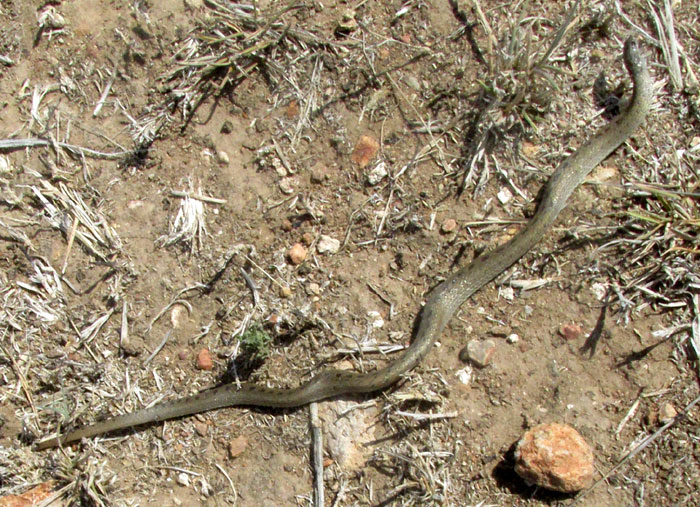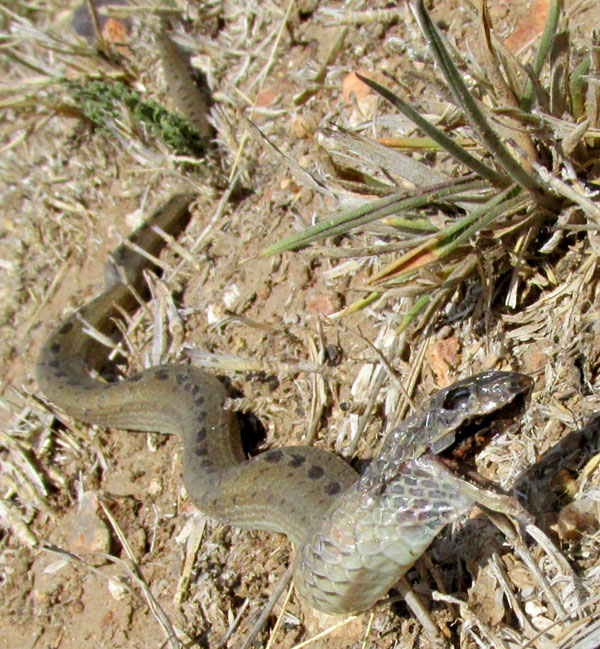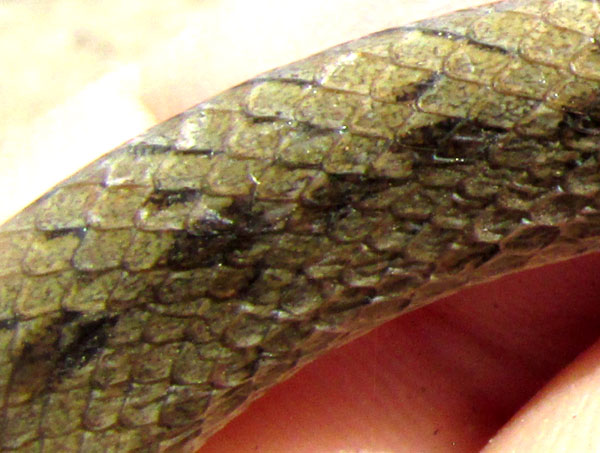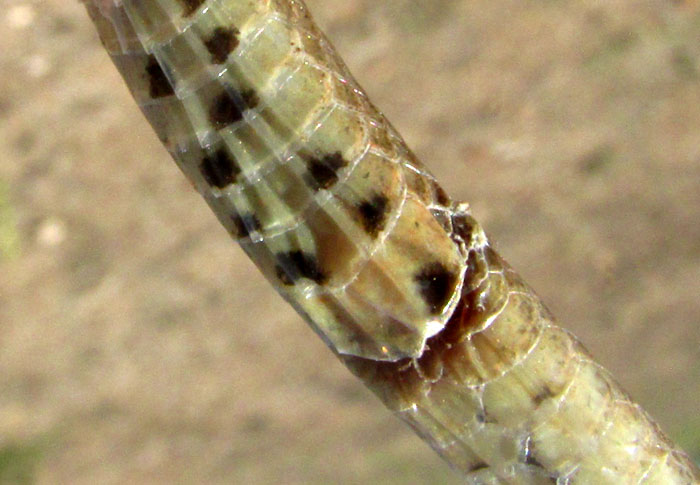Excerpts from Jim Conrad's
Naturalist Newsletter
entry dated August 15, 2022, issued from near Tequisquiapan, elevation about 1,900m (6200 ft), N20.565°, W99.890°, Querétaro state, MÉXICO
PLATEAU MEXICAN EARTHSNAKE

The above 30cm long snake (1ft) appeared in the center of a large, slightly sloping, cleared, grossly overgrazed, eroding field with very thin, rocky soil. Stubs of sparse clumpgrasses still were brown and crispy from a long dry season and a rainy season that failed to come. With the head curiously raised and bent to one side, the snake remained perfectly still, apparently depending on stillness to keep him unseen. However, as I moved ever closer, even too close for any snake, it still didn't move. Then I understood:

The snake was dead, grotesquely frozen with its mouth open. The mouth was filled with dirt, and the facial scales, very important for identification, were too shattered to study. Probably a shepherd with his flock of half-starved sheep saw the perfectly harmless little snake and stomped the head with a heel, leaving it alive enough to raise the head.
It was like finding a beautiful cactus someone had knocked over or macheted for no apparent reason, something often seen here. My first impulse was to just leave, but it's important for certain people to know which snake species are where, so that perhaps someday, if the understandings and sensitivities of humanity in general refine, they'll know how to help the species survive by protecting its habitat.

In the above picture it's seen that along the snake's spine, dark spots appear at regular intervals, with smaller spots ornamenting the sides. Also, the scales are smooth, not "keeled" -- not with slender ridges running lengthwise down their centers, which are present on many species. Several small, brown snake species with smooth scales display similar spotting, but this snake bore spots on its lower, or ventral, surface which were unusual:

Along the snake's entire length, each ventral scale bore one or two conspicuous spots in a fairly random-seeming order. This spotting would prove to be critical for determining the species.

In snakes, the big scale in front of -- on the head side -- of the anus is called the anal plate. Anal plates are important when identifying groups of snakes. Garter snakes, king snakes, and pit vipers, for instance, bear undivided anal plates, while water snakes, racers, and rat snakes have divided ones. In the above picture, the anal plate is the large one above the dark bar crossing from one side of the snake to the other. Its division is hard to see because the snake's skin appears to be wrinkling longitudinally, perhaps because the body was drying out in hot sunlight and wind. But if you look closely you can see a thin, somewhat diagonal fissure indicating that the plate is divided.
Lacking facial scales to refer to, I couldn't "key out" the snake the usual way, but rather on the Internet I searched for images of Querétaro snakes, and matched pictures. The best matches were for the genus Conopsis, a genus whose six species occur only in upland Mexico, from Chihuahua in the north to Oaxaca in the south.
Internet pictures alone weren't adequate to determine the species, but in 2006 Irene Goyenechea and Oscar Flores-Villela published a study entitled "Taxonomic summary of Conopsis. Günther, 1858." Providing excellent species descriptions, distribution maps and, especially helpful, images showing variations of scale patterning for each of the six species, fortunately, it could be downloaded without cost.
Here we have CONOPSIS NASUS, which at least the Naherp.Com website names the Plateau Mexican Earthsnake, despite the species not occurring in English-speaking territory. It's described as usually found under rocks or logs in xerophilous (deserty) underbrush, oak, pine and fir forest, at elevations of 1515-2950m (4950-9700ft). It occurs from Chihuahua in the north to Puebla in the south.
Our big, basically devegetated waste field was bordered on two sides by weedy mesquite hedgerows, maybe a .22 rifle-shot away, so probably that was our snake's home. Possibly it was caught crossing the field at dawn, with no cover in sight. Conopsis species live in burrows, and when threatened try to burrow into the soil. However, the soil in this field was too thin and hard-packed for that. Maybe this explains why the snake's mouth was caked with dirt.
Hardly any behavioral information is available on this species. Various authors quote a "Greer 1966. Copeia 1966:371–373)" work, which I can't locate, describing species in the genus Conopsis as constrictors who feed on lizards and other small animals.
Now we can add to that the information that sometimes Conopsis nasus gets caught in the middle of giant wastelands where apparently they get stomped and left to die.